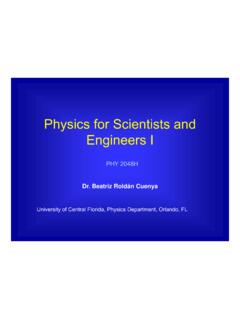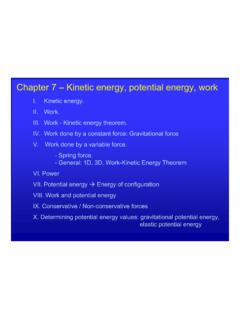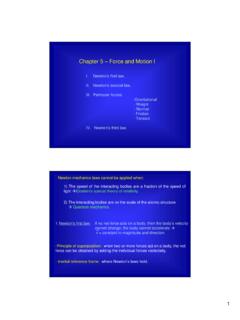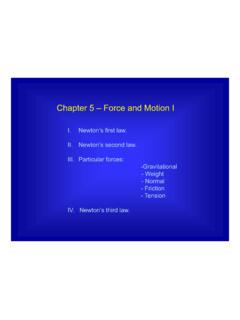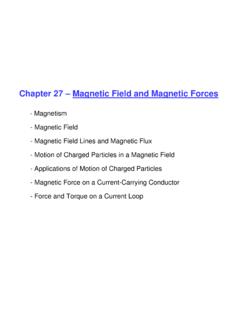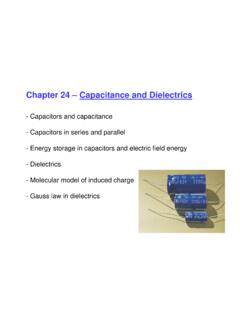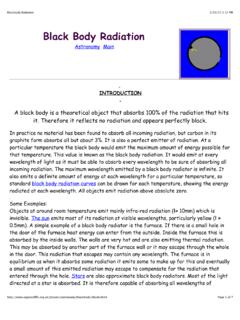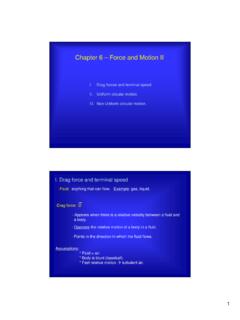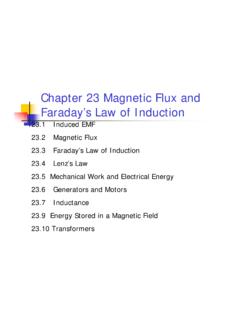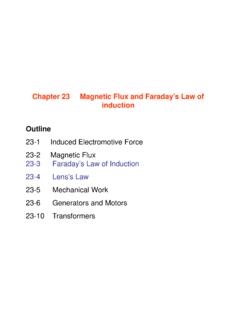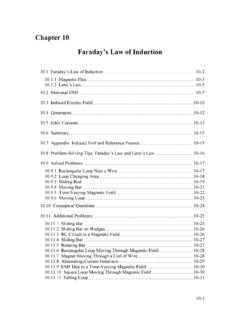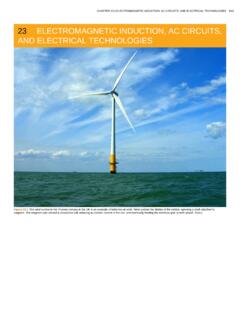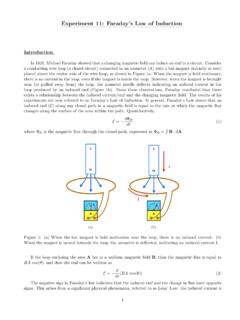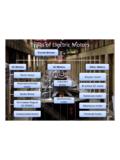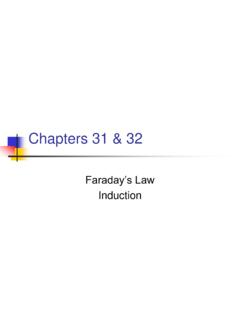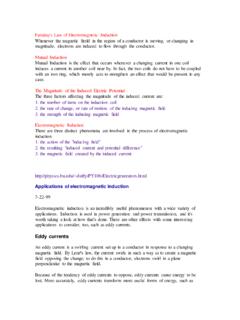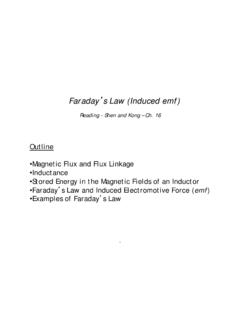Transcription of Chapter 29 – Electromagnetic Induction
1 Chapter 29 Electromagnetic Induction - Induction Experiments - faraday s Law- Lenz s Law- Motional Electromotive Force- Induced Electric Fields- Eddy Currents- Displacement Current and Maxwell s Equations- Superconductivity1. Induction Experiments( faraday / Henry)- If the magnetic fluxthrough a circuit changes, an emf and a current are A time-varying magnetic field can act as source of electric A time-varying electric field can act as source of magnetic An induced current(and emf) is generated when: (a) we move a magnet around a coil, (b) move a second coil toward/away another coil, (c) change the current in the second coil by opening/closing a switch. 2. faraday s Law- Magnetically induced emfs are always the result of the action of non-electrostatic forces. The electric fields caused by those forces are En(non-Coulomb, non conservative).
2 = = dABAdBB cos Magnetic flux: cos = = ABABB If B is uniform over a flat area A: faraday s Law of Induction : -The induced emf in a closed loop equals the negative of the time rate of change of the magnetic flux through the = - Increasing flux < 0 ; Decreasing flux > 0- Direction:curl fingers of right hand around A, if > 0 is in same direction of fingers (counter-clockwise), if < 0 contrary direction (clockwise).- Only a change in the fluxthrough a circuit (not flux itself) can induce emf. If flux is constant no induced If the loop is a conductor, an induced current results from emf. This current produces an additional magnetic field through loop. From right hand rule, that field is opposite in direction to the increasing field produced by electromagnet. dtdNB = Coil:N = number of turnsEx: - Generator I: a simple alternatorExs: , - Generator III: the slide wire generator3.
3 Lenz s LawThe direction of any magnetic Induction effect is such as to oppose the cause of the Alternative method for determining the direction of induced current or emf. -The cause can be changing the flux through a stationary circuit due to varying B, changing flux due to motion of conductors, or If the flux in an stationary circuit changes, the induced current sets up a magnetic field oppositeto the original field if original B increases, but in the same directionas original B if B decreases. - The induced current opposes the change in the flux through a circuit(not the flux itself).- If the change in flux is due to the motion of a conductor, the direction of the induced current in the moving conductor is such that the direction of themagnetic force on the conductor is opposite in direction to its motion ( slide-wire generator).
4 The induced current tries to preserve the status quo by opposing motion or a change of induced downward opposing the changein flux (d /dt). This leads to induced current s Law and the Response to Flux Changes- Lenz s Law gives only the directionof an induced current. The magnitude depends on the circuit s resistance. Large R small induced I easier tochange flux through circuit. - If loop is a good conductor I induced present as long as magnet moves with respect to loop. When relative motion stops I = 0 quickly (due to circuit s resistance).- If R = 0 (superconductor) I induced (persistent current) flows even after induced emf has disappeared (after magnet stopped moving relative to loop).The flux through loop is the same as before the magnet started to move flux through loop of R =0 does not change. Magnetic levitation:-The principle of levitation is Lenz' rule.
5 1) The magnetic field created by the induced current in a metallic sample due to time-fluctuation of the external magnetic field of the coil wants to avoid its cause ( , the coil's fluctuating magnetic field). 2) Thus, the induced magnetic field in the sample and the external fluctuatingmagnetic field of the coil repel each ) The induced magnetic field (and the sample) move away from its cause, away from the coil's magnetic field. Then, for a conical coil (smaller radius at the bottom than at the top) the metallic sample will move upward due to this levitation force, until the force of gravity balances the force of levitation. (The levitation force is larger at the bottom of the conical coil than at the top of the coil).Induced Current / Eddy current levitation: - The rail and the train exert magnetic fieldsand the train is levitated by repulsive forcesbetween these magnetic fields.
6 -B in the train is created by electromagnetsor permanent magnets, while the repulsiveforce in the track is created by a induced magnetic field in conductors within the tracks. -Problems: (1) at slow speeds the current induced in the coils of the track s conductors and resultant magnetic flux is not large enough to support the weight of the train. Due to this, the train needs wheels (or any landing gear) to support itself until it reaches a speed that can sustain levitation. (2) this repulsive system creates a field in the track (in front and behind the lift magnets) which act against the magnets and creates a drag force . This is normally only a problem at low speed. 4. Motional Electromotive ForceBvqF =- A charged particle in rod experiences a magnetic force that causes free charges in rod to move, creating excess charges at opposite ends.
7 - The excess charges generate an electric field (from a to b) and electric force (F = q E) opposite to magnetic force. - Charge continues accumulating until FEcompensates FBand charges are in equilibrium q E = q v B- If rod slides along stationary U-shaped conductor no FB acts on charges in U-shaped conductor, but excess charge at ends of straight rod redistributes along U-conductor, creating an electric = =RvBLRI== =ldBv )( ldBvd =)( -The electric field in stationary U-shaped conductor creates a current moving rod became a source of emf(motional electromotive force).Withinstraight rod charges move from lower to higher potential, and in the rest ofcircuit from higher to lower current:vBL= Length of rod and velocity perpendicular to The emf associated with the moving rod is equivalent to that of a battery with positive terminal at aand negative at b.
8 Motional emf: general form(alternative expression of faraday s law)Closed conducting loop-This expression can only be used for problems involving moving conductors. When we have stationary conductors in changing magnetic fields, we need to use: = -d Induced Electric FieldsnIAABB0 = = dtdInAdtdB0 = =- An induced emf occurs when there is a changing magnetic flux through a stationary A current (I) in solenoid sets up B along its axis, the magnetic flux is:Induced current in loop (I ): I = / R- The force that makes the charges move around the loop is not a magnetic force. There is an induced electric fieldin the conductor caused by a changing magnetic == dtdrEB = 21-The total work done on q by the induced E when it goes once around theloop: W = q E is not E Non-conservative E = 0ldE (stationary integration path)- Cylindrical symmetry E magnitude constant, direction is tangent to loop.
9 = ErldE 2 - faraday s law: 1) an emf is induced by magnetic forces on charges when a conductor moves through ) a time-varying B induces E in stationary conductor and emf. E is induced even when there is no E is non-conservative, non-electrostatic . No potential energy associated, but FE= q Eddy Currents- Induced currents that circulate throughout thevolume of a : B confined to a small region of rotatingdisk Ob moves across B and emf is induced induced circulation of eddy Oa and Oc are not in B, but provide returnconducting paths for charges displaced along Ob toreturn from b to I experiences FBthat opposes disk rotation:(right) current and L downward.(the return currents lie outside B do not experience FB).-The interaction between eddy currents and B causesbraking of =(a) Metal detector (airport security checkpoint) generates an alternating B0that induces eddy currents in conducting object (suitcase).
10 These currentsproduce alternating B that induces current in detector s receiver (I ).(b) Same principle as (a).7. Displacement Current and Maxwell s Equations = enclIldB0 ()EAEdEdAvCq = = = = Ampere s LawdtddtdqiEC == - A varying electric field gives rise to a magnetic a capacitor: conducting wires carry iC(conduction current) into one plate and out of the other, Q and E between plates increase.(incomplete) = CildB0 but also = 0 for surface bulging outContradiction?As capacitor charges, E and Ethrough surface = += enclDCIIldB)(0 dtdEAijDD ==Displacement current (iD): fictitious current in region between capacitor s the flux through curved surface is equivalent in Ampere s law to a conduction current through that surface (iD)Generalized Ampere s Law:Valid for any surface we use: for curved surface ic= 0, for flat surface iD= (flat surface) = iD(curved surface)Displacement current density (jD):The displacement current is the source of B in between capacitor s plates.

